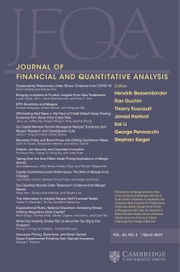Article contents
Public Disclosure and Consumer Financial Protection
Published online by Cambridge University Press: 03 May 2023
Abstract
The U.S. Consumer Financial Protection Bureau has released a database of consumer complaints about banks’ financial products to the public since 2013. We find a greater reduction in mortgage applications to banks that receive more mortgage complaints in local markets after the disclosures. The effect is stronger in areas with more sophisticated consumers and higher credit competition, and for banks receiving more severe complaints. The number of monthly mortgage complaints per bank exhibits faster mean reversion after the publication of the database. These findings suggest that the public disclosure of mortgage complaints enhances product market discipline and consumer financial protection.
Information
- Type
- Research Article
- Information
- Journal of Financial and Quantitative Analysis , Volume 59 , Issue 5 , August 2024 , pp. 2164 - 2198
- Creative Commons
- This is an Open Access article, distributed under the terms of the Creative Commons Attribution licence (https://creativecommons.org/licenses/by/4.0), which permits unrestricted re-use, distribution and reproduction, provided the original article is properly cited.
- Copyright
- © The Author(s), 2023. Published by Cambridge University Press on behalf of the Michael G. Foster School of Business, University of Washington
Footnotes
We thank two anonymous reviewers, Mary Brooke Billings, Mark Bradshaw, Claire Brennecke (discussant), Dennis Campbell, Jennifer Conrad (the editor), Aiyesha Dey, Al Ghosh, Joao Granja (discussant), Ilan Guttman, Jonas Heese, Disen Huang, Mingyi Hung, April Klein, Christian Leuz, Geng Li, David Mauer, Minh Phan, Stephen Ryan, Philipp Schnabl, Crystal Shi, David Yermack, Xianming Zhou, Chenqi Zhu, and seminar participants at the Federal Reserve Board, New York University, Hong Kong University of Science and Technology, Harvard Business School, UNC Charlotte, Australian National University, London Business School Trans-Atlantic Doctoral Conference, the 2019 NYU Summer Camp, the 2019 CFEA conference, and the 2019 CFPB research conference for helpful comments.
References
- 8
- Cited by

